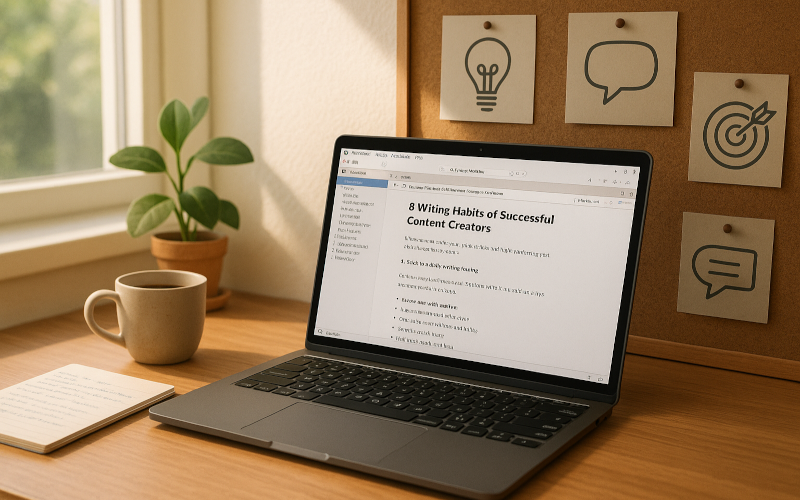Heads up: This post may have affiliate links. As an Amazon Associate, I earn from qualifying purchases.

8 Writing Habits of Successful Content Creators
Behind every strong blog, viral article, or high-performing post is something less flashy than inspiration. It isn’t magic. It isn’t luck. It’s habits. Small, steady actions that separate dabblers from doers. Habits are what turn “someday writers” into consistent creators who publish week after week.
Whether you write blog posts, newsletters, video scripts, or captions, becoming a creator who writes well and often starts with simple daily moves. Think of these habits like a compass. They keep you pointed in the right direction so you don’t stare at a blinking cursor all day.
Let’s lay out eight writing habits you can start building today. No fancy degrees needed. Just clear steps, steady effort, and a couple of helpful tools from your affiliate partners.
1) Stick to a daily writing routine
If you only write when you “feel like it,” you won’t write much. Pros don’t trust moods. They trust routine.
Pick a time and a place. Morning before the house wakes up. Lunch in the truck. Late evening when things are quiet. Ten minutes a day beats four hours once a month. Show up, even if it’s ugly. Momentum is the secret.
Case Study
Stephen King is famous for writing every single morning. Rain or shine, holiday or not, he’s at his desk by 8 a.m. That steady rhythm is how he’s written over 60 novels and hundreds of short stories. It’s not about bursts of genius. It’s about showing up daily.
Helpful tool: Build your routine inside Scrivener. It’s built for writers from daily notes to book-length projects and keeps all your work in one tidy place.
2) Always start with an outline
Blank pages kill momentum. Outlines save it. An outline is your map. Jot the main idea, list the sections, and note the key examples. Now you’ve got rails to run on.
Want to visualize it? Mind maps help you see the big picture before you write your first sentence.
Example
Think of your outline like a grocery list. Without one, you wander the store, waste time, and forget the milk. With one, you’re efficient, faster, and less stressed. Writing works the same way.
Helpful tool: Mind-mapping and diagram tools in the Wondershare suite can make fast work of outlines:
3) Write in short, scannable chunks
Online readers scan. Give them short sentences, short paragraphs, subheads, and bullet points. Make the page easy on the eyes.
Clean visuals keep folks on the page longer and break up text. Use images, icons, and simple graphics that match your theme.
Case Study
The Nielsen Norman Group found that 79% of web users scan instead of reading word-for-word. The lesson: scannability isn’t optional. It’s survival.
Helpful tools:
• Stock vectors and illustrations at VectorStock.
• Create simple banners or cover images with CorelDRAW.
4) Edit in stages, not all at once
Writing and editing at the same time is like mowing and raking at the same time. You’ll miss spots.
Do it in layers.
• Pass one: structure and flow.
• Pass two: word choice and clarity.
• Pass three: grammar and small fixes.
• Final pass: read it out loud.
Example
Think of it like washing your truck. First you spray it down. Then scrub. Then rinse. Finally, polish. Each step makes it cleaner. Editing in passes works the same way.
Helpful tool: If you mark up PDFs or deliver drafts to clients, Wondershare’s tools keep your workflow neat:
5) Read your writing aloud
It feels odd, but it works. Reading out loud exposes clunky lines, long sentences, and awkward rhythm. If it sounds rough, it will read rough.
Example
I once read a blog draft aloud to my wife. She stopped me halfway: “Why are you breathing so hard?” Turns out, my sentences were so long I couldn’t read them without gasping. Cutting them in half fixed the problem instantly.
Circle the lines that trip you up. Shorten them. Swap big words for plain ones. Make it sound like a real person talking across a table.
6) Track your progress and goals
What gets measured gets managed. Log word count. Track draft dates. Note publish dates. Watch streaks. Celebrate small wins.
A simple dashboard helps you keep promises to yourself and spot patterns. Are mornings better? Do you draft faster after an outline? Use the data to improve.
Case Study
Jerry Seinfeld famously used the “Don’t Break the Chain” method. He marked an X on the calendar every day he wrote. Over time, the chain of Xs grew, and he didn’t want to break it. That simple system built a legendary comedy career.
Helpful tools:
• Build your writing log inside Scrivener it keeps projects organized and helps you stay on track.
• Organize simple dashboards and checklists with Wondershare solutions.
• Level up skills with Lead Academy courses for writers and creators.
7) Learn from feedback
Don’t dodge edits. Invite them. Ask a reader or peer:
• What confused you?
• What did you like?
• Where did it drag?
Look for patterns. If three people say your intro is slow, it’s slow. Tighten it. Feedback is not an attack. It’s a shortcut.
Case Study
JK Rowling was rejected by a dozen publishers before Harry Potter saw print. Each rejection included some form of feedback. Instead of quitting, she kept adjusting. Feedback, even when painful, sharpened the work until it became a global phenomenon.
Helpful tool: Build skills and get structured practice with Lead Academy writing and communication courses:
8) Write for the reader, not just yourself
Before you draft, ask three questions: Who is this for? What do they want to know? How will this help them today?
Use their words. Solve their problems. Trim anything that doesn’t serve the reader. When it matters to them, they keep reading and they keep coming back.
Example
Think of writing like cooking. If you’re making dinner for guests, you don’t only cook what you want. You consider their tastes, allergies, and preferences. Great writers do the same for readers.
Helpful step after publishing: Announce big guides, case studies, or launches with a press release to drive early discovery and links.
7-Day Writing Habit Starter Plan
Want to put these habits into practice? Here’s a simple plan:
Day 1: Pick your writing time. Set a timer for 15 minutes. Write anything.
Day 2: Create a short outline for tomorrow’s writing.
Day 3: Write your first draft using short, scannable paragraphs.
Day 4: Edit in two passes (structure + clarity).
Day 5: Read your draft aloud. Mark every stumble. Revise.
Day 6: Log your progress in Scrivener or a simple tracker.
Day 7: Share your draft with a peer or group (Lead Academy has great options). Ask for feedback.
Repeat the cycle. Add minutes as you go. By the end of the month, you’ll have a routine, a stack of drafts, and stronger habits.
Great writing isn’t born. It’s built. These eight habits are simple, but they work. Start with one this week. Add another next week. Keep showing up and the quality climbs. That’s how pros get it done.
